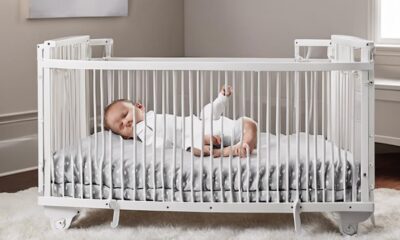Sleep Training
My Newborn Doesn't Sleep: 5 Effective Strategies for Better Rest
Lacking sleep with a newborn? Discover innovative strategies that could be the answer to your restful nights.

When our newborn doesn't sleep, frustration can set in quickly. We've tried the usual tricks, but nothing seems to work.
However, in our quest for better rest, there are strategies that might just explore things around. These methods go beyond the typical advice and explore into practical solutions that could be the key to finally getting some much-needed sleep.
Key Takeaways
- Establish a consistent bedtime routine early on for predictability and comfort.
- Create a calm sleep environment with blackout curtains and soothing rituals.
- Practice safe sleep habits like back sleeping and proper room temperature.
- Encourage self-soothing techniques to promote independent sleep habits.
Establishing a Consistent Bedtime Routine
To set the stage for peaceful nights and restful sleep for your newborn, begin by establishing a consistent bedtime routine early on. Babies thrive on predictability, and a regular schedule can help regulate their internal clock for better sleep patterns.
Introducing calming activities such as a warm bath and gentle lullabies can signal bedtime to your little one, preparing them for a good night's rest. Dimming lights and reducing noise in the evening create a soothing environment that promotes relaxation and sleep readiness.
By following a predictable sequence of activities each night, you can communicate to your baby that it's time to wind down and prepare for sleep. Starting a bedtime routine as early as 6 to 8 weeks old can lay the foundation for healthy sleep habits that will benefit your newborn in the long run.
Consistency is key in establishing a bedtime routine that works for both you and your baby, setting the stage for peaceful nights and restful sleep.
Creating a Calm Sleep Environment
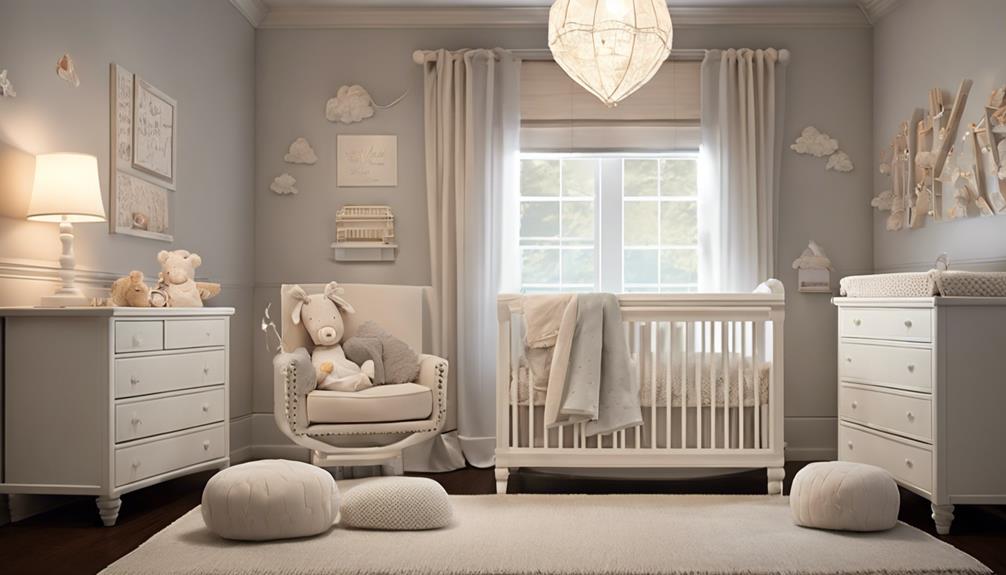
Creating a calm sleep environment for your newborn involves maintaining a quiet and comfortable space conducive to restful nights. To help you achieve this, consider the following tips:
- Use blackout curtains: These can help block out light and reduce stimulation, creating a more peaceful environment for your baby to sleep in.
- Opt for a firm mattress: Ensuring your baby sleeps on a firm mattress can promote better sleep quality and reduce the risk of suffocation.
- Incorporate soothing bedtime routines: Engage in calming activities like gentle music, dim lighting, and a warm bath before bedtime to help your baby relax and prepare for sleep.
Implementing Safe Sleep Practices
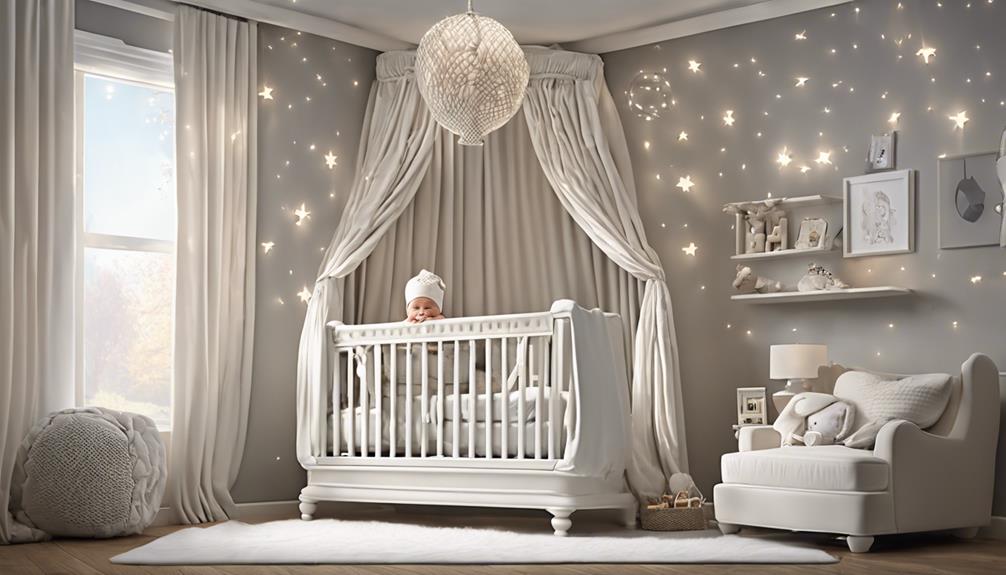
Ensuring your baby's safety during sleep is essential for their well-being and your peace of mind. To reduce the risk of SIDS, always place your newborn on their back, as recommended by the American Academy of Pediatrics.
For added safety, consider room-sharing for the first 6 months to decrease the chances of SIDS by up to 50%.
It's vital to create a safe sleep environment by avoiding soft bedding, toys, and loose blankets that could pose suffocation hazards. Maintaining a comfortable room temperature between 68-72°F is also important for your baby's safety during sleep.
Additionally, regularly check that the crib meets safety standards to prevent any accidents.
Encouraging Self-Soothing Techniques
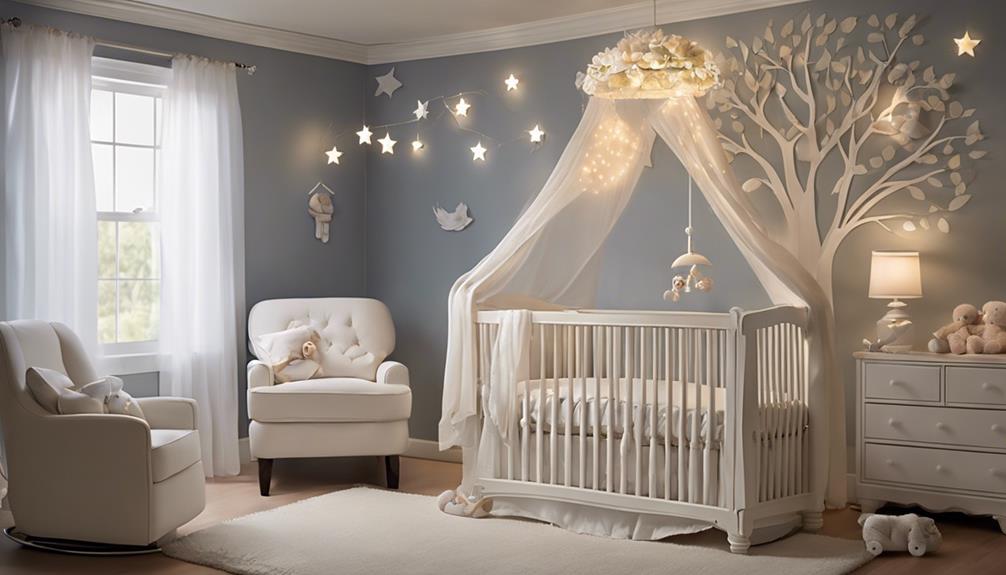
How can we help our babies develop the ability to self-soothe and sleep better? Encouraging self-soothing techniques is key to promoting better sleep habits and independent sleep. Here are some practical tips to assist you in fostering your baby's self-soothing abilities:
- Start by creating a bedtime routine: Establishing a consistent bedtime routine can signal to your baby that it's time to wind down and prepare for sleep. This predictability can help them feel secure and more inclined to self-soothe.
- Put your baby down drowsy but awake: Placing your baby in the crib when they're drowsy but still awake can help them learn to self-soothe as they drift off to sleep. This encourages them to settle themselves without relying on external soothing methods.
- Gradually reduce soothing methods: As your baby grows, gradually reduce the amount of external soothing they receive. This gradual withdrawal can allow them to develop their self-soothing skills over time, leading to improved sleep patterns and overall better rest for both baby and parents.
Seeking Support and Guidance

For parents dealing with newborn sleep challenges, seeking support and guidance is essential in finding effective solutions and reassurance. Understanding the overwhelming need for help during those sleepless nights and the importance of reaching out for assistance. Sometimes, as first-time parents, we may feel lost in trying to help our babies fall back asleep. It's okay to ask for help; all parents need support during this time. Here are some options to take into account:
| Support Options | Description | Benefits |
|---|---|---|
| Consult with a Pediatrician or Sleep Specialist | Expert guidance on newborn sleep issues | Professional advice tailored to your baby's needs |
| Join Support Groups | Connect with other parents facing similar challenges | Emotional support and shared experiences |
| Enroll in Sleep Training Programs | Tailored programs to help babies develop healthy sleep habits | Structured approach for better sleep routines |
Frequently Asked Questions
How Do You Survive a Lack of Sleep With a Newborn?
We survive lack of sleep with a newborn by sharing nighttime duties, establishing a bedtime routine, seeking help from loved ones or professionals, and prioritizing rest when possible. It's tough, but support and teamwork make it manageable.
How Can I Get My Newborn to Sleep Better?
Struggling to get your newborn to sleep better? We've been there. Consistent routines, soothing techniques, and understanding hunger cues can make a world of difference. Trust us; with patience and guidance, better rest awaits.
What to Do When Your Baby Is Overtired and Won't Sleep?
When our baby is overtired and won't sleep, we focus on calming activities like gentle rocking or singing lullabies. We dim the lights, reduce noise, and stick to a soothing bedtime routine. Consistency is key for helping them relax and drift off peacefully.
Why Won't My Newborn Go Down to Sleep?
When newborns struggle to sleep, it could be due to hunger, discomfort, or a need for attention. Establishing a consistent bedtime routine and responding to their cues can create a better sleep environment for them.
Conclusion
As parents, comprehend the challenges of having a newborn who struggles to sleep. By implementing these effective strategies, can create a peaceful environment for our little ones to rest and grow.
Let's embrace the journey of parenthood with patience and perseverance, knowing that seeking support and guidance is key to overcoming any obstacles. Together, can help our babies develop healthy sleep habits and enjoy better rest for the whole family.
Pamela is the voice behind our vibrant community, fostering connections and conversations among parents. Her expertise in community engagement and personal experiences as a parent fuel her passion for creating a supportive space for all. Pamela believes that community is crucial for navigating the complexities of parenting, offering a place for sharing, learning, and growing together.
Sleep Training
5 Reasons Why Newborns Grunt in Their Sleep
Discover the surprising truth behind why newborns grunt in their sleep – it's not what you think!
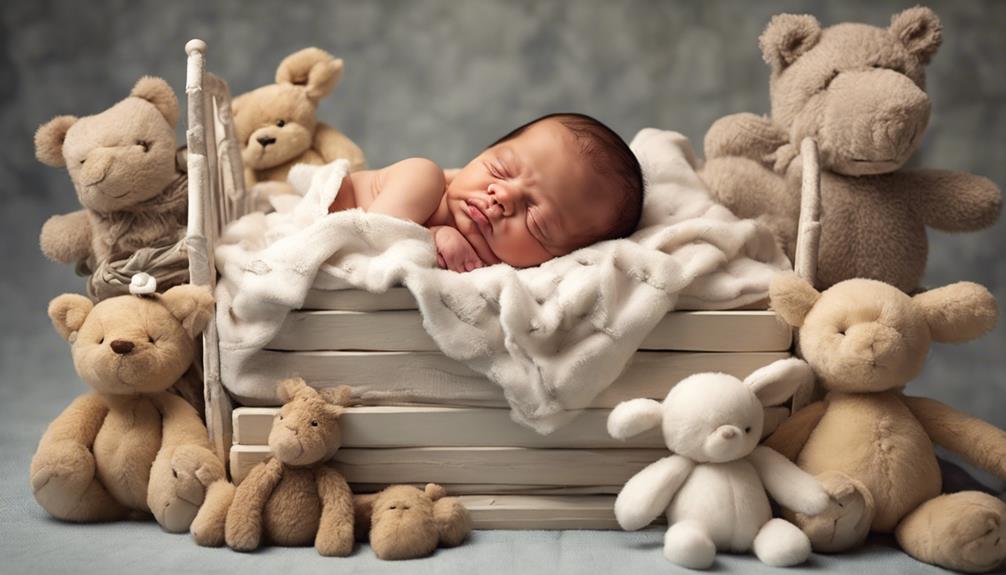
As fascinating as it sounds, did you know that approximately 60% of newborns exhibit grunting sounds during sleep?
Curious about why these little ones make such noises? Well, let's uncover the mystery behind 5 common reasons why newborns grunt in their sleep.
Key Takeaways
- Digestive issues like infant dyschezia and constipation can lead to newborn grunting.
- Grunting helps newborns adjust breathing patterns, indicating respiratory factors at play.
- Acid reflux and blocked nasal passages are common causes of grunting in infants.
- Gas discomfort from swallowing air during feeding can also contribute to newborn grunting.
Bowel Movements
When newborns grunt in their sleep, it can be a sign of potential challenges related to their bowel movements and stool passage. Infant dyschezia, a common occurrence as babies learn to defecate, can lead to grunting and straining. Soft, mushy stools are typical for newborns, but hard, dry stools may indicate constipation. This discomfort can cause babies to use their diaphragm muscles to push out stool, resulting in the grunting sounds we hear during sleep.
It's crucial to pay attention to your baby's bowel movements to ensure they're passing stool comfortably. Factors like irregular breathing, chest congestion, and illnesses can also contribute to newborn grunting in sleep. If you notice your baby having difficulty passing stool or if their stool consistency changes notably, it's advisable to consult with a healthcare provider for guidance on how to alleviate any potential issues related to bowel movements. Remember, we're here to support you through these challenging moments.
Acid Reflux
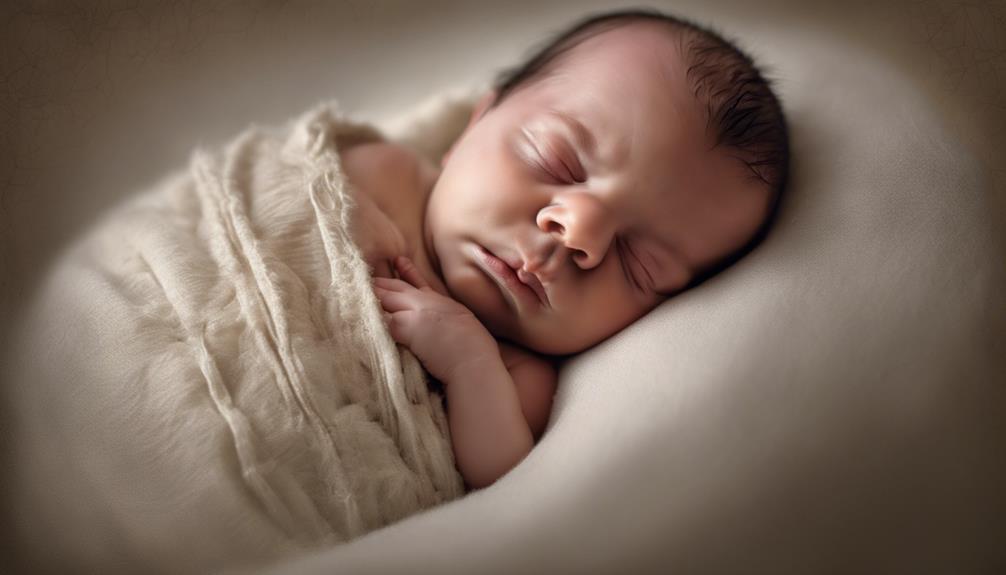
How does acid reflux impact the sleep of newborns? Acid reflux in babies can disrupt their sleep patterns, leading to discomfort and grunting sounds throughout the night. Here are some key points to contemplate:
- Common Issue: Acid reflux is a common problem among infants, causing them to experience frequent spit-ups and grunting noises while sleeping.
- Consultation: If your baby is consistently showing symptoms of acid reflux such as grunting and irritability during sleep, it's advisable to seek guidance from a pediatrician.
- Management: Simple measures like keeping the baby upright after feeding and using specialized formulas can often help alleviate mild cases of acid reflux in babies.
- Severe Cases: In more severe instances where acid reflux significantly disturbs the baby's sleep or leads to complications, medical attention may be necessary to manage the condition effectively.
Understanding how acid reflux impacts your baby's sleep is vital in providing the necessary support and care to make sure they rest comfortably.
Blocked Nasal Passages
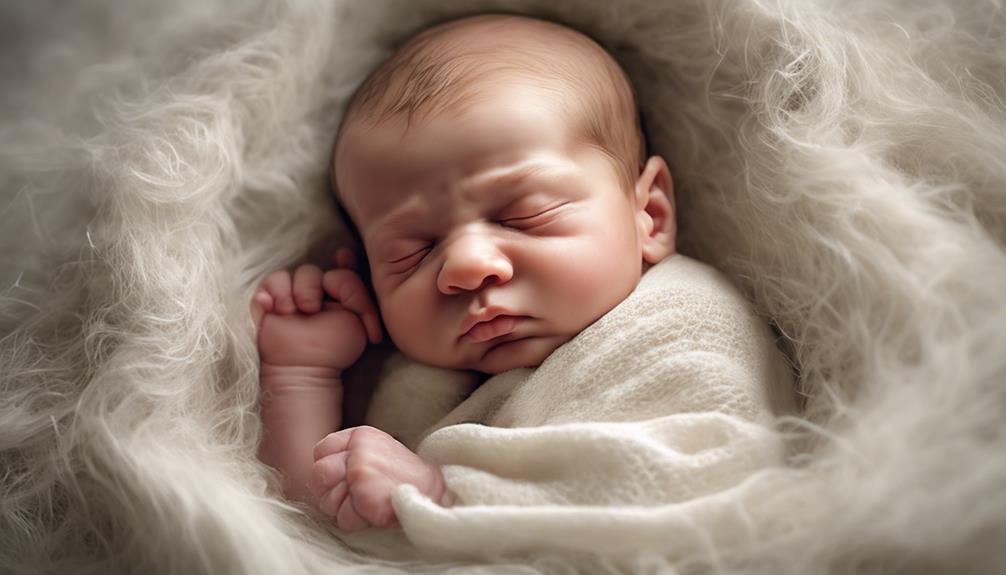
Blocked nasal passages in newborns can often result in grunting sounds during their sleep. Newborns have tiny nasal passages that can easily become blocked due to mucus or congestion, making it challenging for them to breathe comfortably. This congestion can lead to grunting noises as the baby struggles to breathe through the narrow passages. Clearing a baby's nasal passages gently can help alleviate the blockage and reduce the grunting during sleep. It is important to handle this issue delicately to guarantee the baby's breathing is not further compromised. Blocked nasal passages can also cause snoring sounds in newborns, indicating that they are having difficulty breathing properly. By keeping the baby's nasal passages clear, parents can help improve their little one's breathing and reduce the occurrence of grunting and snoring sounds during sleep.
| Blocked Nasal Passages in Newborns | Effects |
|---|---|
| Small airways and mucus | Grunting sounds during sleep |
| Congestion | Breathing difficulties |
| Narrow nasal passages | Snoring noises |
| Clearing nasal passages | Enhanced breathing |
Oxygen Intake

Shifting between sleep stages, newborns may experience changes in oxygen intake, which can lead to grunting sounds as they regulate their breathing to improve oxygen levels. Understanding why newborns grunt in their sleep due to oxygen intake can offer valuable insights into their well-being.
- Regulating Breathing: Grunting helps newborns adjust their breathing patterns to enhance oxygen intake, essential for their growing bodies.
- Respiratory Rate Variability: Factors like respiratory rate can affect how newborns grunt during sleep, indicating their effort to optimize oxygen flow.
- Oxygen Saturation Levels: Monitoring oxygen saturation levels can reveal if grunting is linked to low oxygen levels, prompting timely interventions.
- Health Implications: Proper oxygen intake is essential for newborns' health and development, underscoring the importance of observing their breathing patterns during sleep.
Gas Passing
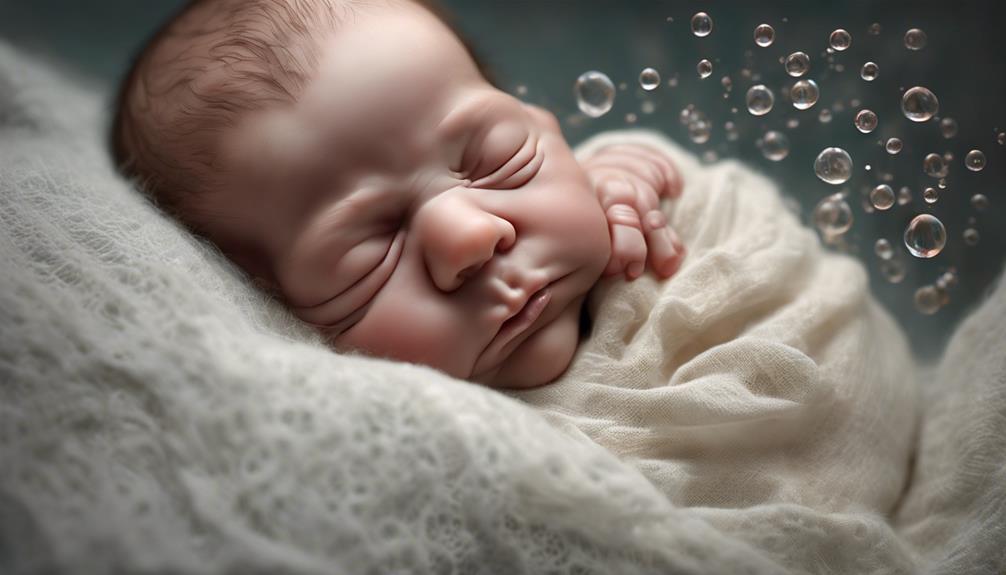
Newborns may also grunt in their sleep due to discomfort caused by gas passing. When babies swallow air during feeding, it can lead to gas buildup in their tiny tummies, causing gassiness and resulting in grunting sounds during sleep. Their immature digestive systems can struggle to process this gas efficiently, leading to further discomfort. This discomfort manifests as grunting while the baby tries to pass the gas.
To help alleviate this issue, gentle tummy massages can be beneficial in relieving gas and reducing the frequency of grunting episodes. These massages can aid in moving the trapped gas along the digestive tract, providing relief to the baby. Additionally, ensuring proper burping techniques after feeding can help minimize the amount of swallowed air, ultimately reducing gas buildup and potential grunting during sleep.
Understanding the connection between gas passing discomfort and newborn grunting can assist caregivers in comforting and aiding their little ones for a more peaceful sleep.
Frequently Asked Questions
Why Does My Baby Grunt so Much While Sleeping?
We acknowledge the concern when babies grunt in their sleep. It's typical as they learn muscle control. If your baby seems uncomfortable or there are other symptoms, consulting a healthcare provider is essential for peace of mind.
Why Does My Newborn Make Strange Noises While Sleeping?
We all wonder why our newborns make strange noises during sleep. It's often due to their developing systems. Grunting helps regulate breathing and digestion. Most sounds are normal, but understanding these behaviors is key to easing parental concerns.
Why Is My Baby Grunting While Breathing?
I comprehend how concerning it is to hear your baby grunt while breathing. Grunting in newborns is often due to their developing respiratory system and airway size. It helps regulate breathing, especially during deep sleep.
Why Does My Newborn Make a Choking Sound While Sleeping?
It is understood that newborns might make choking sounds while sleeping due to their developing airways and mucus. It's natural for them to adjust breathing patterns. Recognizing these behaviors can reassure parents and differentiate normal noises from distress signals.
Conclusion
To sum up, it's common for newborns to grunt in their sleep due to various reasons such as bowel movements, acid reflux, blocked nasal passages, oxygen intake, and gas passing. Understanding these factors can help ease parental concerns and navigate through these sounds with confidence.
Did you know that up to 70% of newborns experience some form of acid reflux in their first few months of life? It's important to be aware of these common issues to provide the best care for your little one.
Pamela is the voice behind our vibrant community, fostering connections and conversations among parents. Her expertise in community engagement and personal experiences as a parent fuel her passion for creating a supportive space for all. Pamela believes that community is crucial for navigating the complexities of parenting, offering a place for sharing, learning, and growing together.
Sleep Training
How My Newborn Won't Sleep in Bassinet: A Guide to Help
Lullabies and soothing techniques could be the key to finally getting your newborn to sleep in their bassinet – find out how!
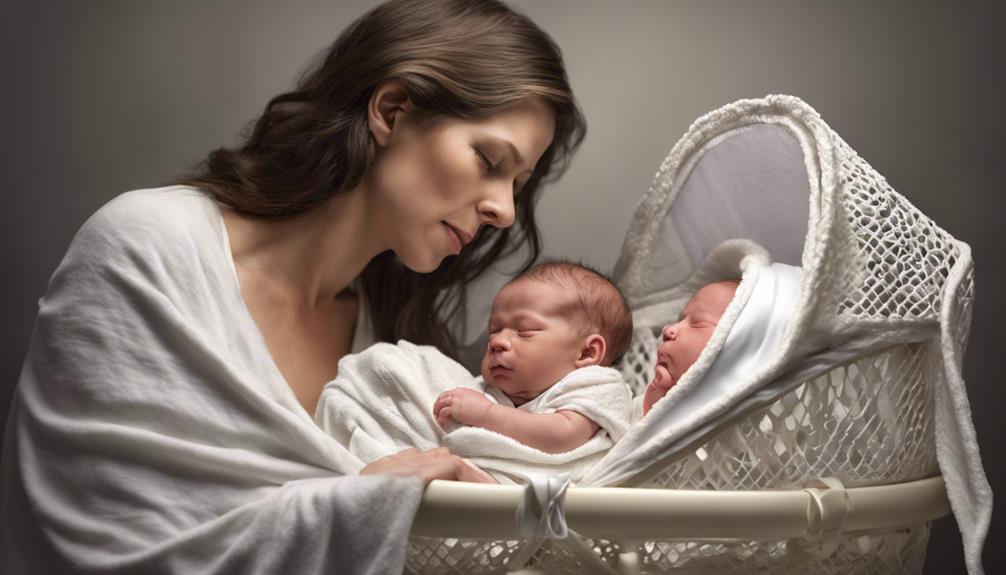
As parents, we empathize with the frustration that comes with a newborn who just won't settle in their bassinet. The constant waking, the endless rocking – it can feel like an endless cycle.
But what if we told you there might be a simple solution to help your little one drift off peacefully? Stay tuned to uncover practical tips and strategies that could make a world of difference in your baby's sleep routine.
Key Takeaways
- Address discomfort and habits gently to ease bassinet sleep resistance.
- Importance of bassinet sleep for newborns: safety, bonding, and healthy habits.
- Tips: swaddle, safe environment, routine, and pacifiers for newborn sleep.
- Cozy sleep environment: soft bedding, ideal temperature, safety guidelines, and simplicity.
Common Reasons for Bassinet Sleep Resistance
If your newborn is resisting sleep in the bassinet, it's common for parents to feel overwhelmed by the situation. Sleep resistance can stem from various factors like discomfort, gas, reflux, or overtiredness. Sometimes, babies develop learned habits of being held, making them prefer sleeping in your arms rather than the bassinet. Moving to the bassinet requires patience and consistency to break these existing habits gently.
Associations play a significant role in your baby's preference for sleep environments. They may resist the bassinet because it doesn't align with their familiar sleep associations. Understanding the root causes behind this resistance, such as addressing any discomfort or breaking learned habits, can help your baby adapt to sleeping in the bassinet more easily.
Importance of Bassinet Sleep for Newborns
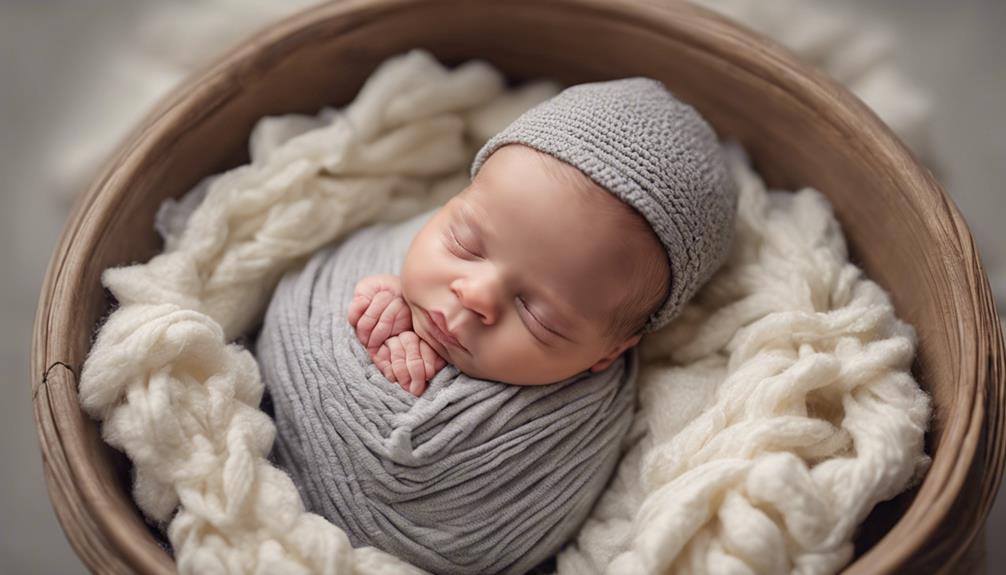
When newborns sleep in a bassinet, they benefit from a safe and nurturing environment that promotes healthy sleep practices recommended by the AAP. The American Academy of Pediatrics (AAP) suggests bassinet sleep as a way to reduce the risk of SIDS (Sudden Infant Death Syndrome) in newborns. Room-sharing with a baby in a bassinet not only fosters a strong bond but also enables easy monitoring during sleep, giving parents peace of mind. By having newborns sleep on a flat surface in a bassinet without additional items, the chances of suffocation and overheating are minimized. Establishing a routine of bassinet sleep early on can help instill healthy sleep habits that will benefit the baby in the long run. Bassinets provide a secure and snug space for newborns to rest comfortably, ensuring they have a peaceful sleep environment conducive to their growth and development.
| Benefits of Bassinet Sleep for Newborns | |
|---|---|
| Reduces risk of SIDS | |
| Promotes bonding with parents | |
| Prevents suffocation and overheating | |
| Establishes healthy sleep habits | |
| Provides a cozy and secure sleep space |
Tips for Getting Newborns to Sleep

Introducing the bassinet consistently for naps and bedtime can help create a familiar and comforting sleep environment for your newborn. When it comes to getting your newborn to sleep, here are some tips to guide you:
- Swaddle: Wrapping your baby snugly in a swaddle can provide a sense of security and mimic the coziness of the womb.
- Crib: Make sure the crib or bassinet is free of loose bedding or toys to maintain a safe sleep space for your baby.
- White Noise Machine: Using a white noise machine can help drown out other sounds and create a soothing environment for your little one.
- Bedtime Routine: Establishing a consistent bedtime routine can signal to your newborn that it's time to sleep, making the change to the bassinet smoother.
- Pacifiers: Offering a pacifier can help comfort your baby and satisfy their need to suck, promoting relaxation and sleep.
Creating a Cozy Sleep Environment
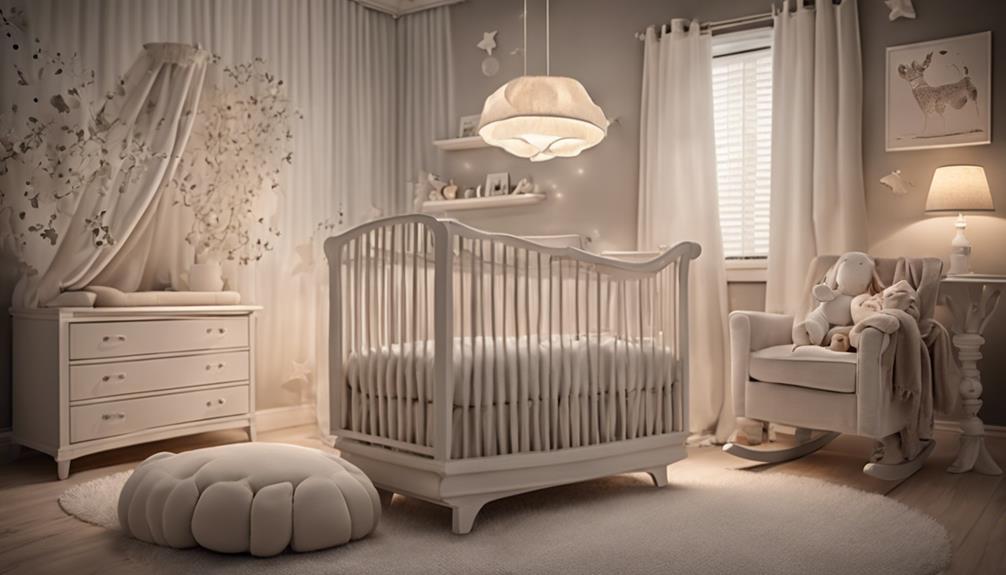
To guarantee your newborn feels cozy and secure in the bassinet, focus on creating a sleep environment that promotes comfort and safety.
Use soft, breathable bedding in the bassinet to provide a gentle surface for your baby to rest on. Make sure the bassinet is positioned away from drafts and direct sunlight to maintain an ideal sleeping environment. Keep the room temperature between 68-72 degrees Fahrenheit to help your little one sleep better.
Consider using a fitted sheet and a sleep sack to keep your baby snug and secure during the night. Remember to follow safe sleep guidelines and avoid overcrowding the bassinet with toys or extra bedding to prevent suffocation risks.
Addressing Newborn Sleep Challenges

Browsing through newborn sleep challenges requires comprehension and patience to help your little one adjust to the comfort of sleeping in a bassinet. When your newborn won't sleep in a bassinet, it can be frustrating, but with persistence and understanding, you can overcome these hurdles.
Here are some practical tips to address newborn sleep challenges:
- Identify Discomfort: Check for reflux, gas, or other discomforts that may be causing your baby to resist the bassinet.
- Combat Overtiredness: Make sure your baby isn't too tired when trying to put them down in the bassinet.
- Break Sleep Habits: Help your baby shift by gently breaking habits of only sleeping in your arms.
- Consistency is Key: Establish a consistent bedtime routine to signal to your baby that it's time to sleep in the bassinet.
- Be Patient: Remember, habits take time to change, so be patient and consistent in your efforts.
Conclusion
To sum up, establishing healthy sleep habits for newborns can be challenging, but with patience and persistence, it's possible to get them to sleep in a bassinet. Remember, 80% of infants who sleep in a safe sleep environment are less likely to experience sleep-related incidents.
By creating a cozy sleep environment, addressing newborn sleep challenges, and following safe sleep practices, parents can help their little ones develop independent sleep habits for a better night's rest.
Nancy combines her love for writing with a deep understanding of the diverse dynamics of family life. As a parent, she brings personal experience and empathy to her work, covering topics from early childhood to the teenage years. Nancy’s work is driven by the belief that every family’s story is unique, and sharing these stories can inspire and support others on their parenting journey.
Sleep Training
7 Best Newborn Sleep Sacks for Peaceful Nights
Wondering which newborn sleep sack will truly deliver peaceful nights for both baby and parents? Discover the top 7 picks that prioritize comfort and safety.
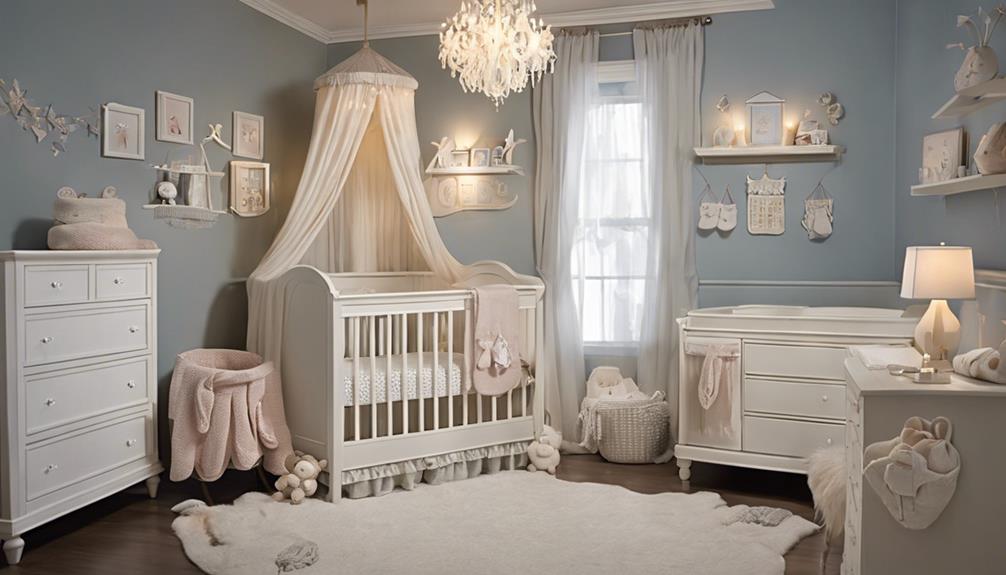
Have you ever wondered which newborn sleep sacks truly deliver peaceful nights for both baby and parents?
When it comes to ensuring quality rest for your little one, the selection of the right sleep sack is key.
From fostering a secure swaddle to providing breathable comfort, these 7 top-rated sleep sacks are designed to promote serene sleep environments.
But what sets them apart and makes them the go-to choices for many families seeking a peaceful night's rest?
Key Takeaways
- HALO SleepSack promotes healthy hip development with 100% cotton and secure swaddle design.
- Ergopouch Swaddle Sack offers versatility with organic cotton and a snug mimicking swaddle fit.
- Baby Deedee Sleep Nest Lite ensures a safe and cozy sleep environment with lightweight fabric.
- Copper Pearl Sleep Bag combines luxury, warmth, and convenience for peaceful nights.
HALO Sleepsack 100% Cotton Swaddle
When considering newborn sleep solutions, the HALO SleepSack 100% Cotton Swaddle stands out as a versatile and beneficial choice. Recognized by the International Hip Dysplasia Institute for promoting healthy hip development, this sleep sack offers a secure swaddle that's gentle on a baby's skin. The breathable fabric not only guarantees comfort but also aids in creating better sleep patterns for infants, leading to more peaceful nights for both baby and parents.
The HALO SleepSack Swaddle is designed to provide a snug and secure wrap for newborns, making them feel safe and cozy. Its 100% cotton material isn't only soft but also breathable, allowing for adequate airflow to prevent overheating during sleep. By offering this gentle and comfortable swaddle, parents can help their little ones settle into a more restful sleep routine, resulting in a calmer and more rejuvenating experience for the entire family.
Primary Muslin Sleep Sack

Primary Muslin Sleep Sacks are a popular choice for newborns due to their lightweight and breathable muslin fabric, ideal for warmer nights.
The vibrant colors and zipper design make it easy for parents to dress and undress their baby for diaper changes.
With a sleeveless style to prevent overheating, this sleep sack offers both comfort and convenience for peaceful nights.
Breathable Fabric Choice
Crafted from lightweight and breathable muslin fabric, the Primary Muslin Sleep Sack offers excellent comfort and ventilation for newborns during sleep. This fabric is gentle on delicate newborn skin, boasting softness that reduces the risk of irritation.
The breathable design aids in regulating the baby's body temperature, preventing overheating and ensuring a peaceful slumber. Featuring a convenient zipper closure, this sleep sack simplifies dressing and diaper changes for both parents and babies.
Additionally, the Primary Muslin Sleep Sack comes in colorful designs, adding a fun touch to your newborn's bedtime routine. Its practicality, combined with the vibrant aesthetics, makes it a charming choice for ensuring your little one's cozy and secure rest.
Secure Fastening Options
The secure fastening option on the Primary Muslin Sleep Sack guarantees your newborn stays snug and safe throughout the night. The zipper closure ensures a secure sleep environment, allowing your baby to rest peacefully. Here are three key points about this feature:
- The zipper closure on the Primary Muslin Sleep Sack keeps your baby securely wrapped, preventing any unravelling during sleep.
- Designed with gentle materials, the zipper closure is soft on your baby's delicate skin, promoting a comfortable night's sleep.
- This convenient feature makes nighttime diaper changes a breeze, allowing you to attend to your newborn quickly without disturbing their rest.
With the Primary Muslin Sleep Sack, both you and your baby can enjoy a peaceful night's sleep.
Baby Deedee Sleep Nest Lite Sleeping Bag Sack
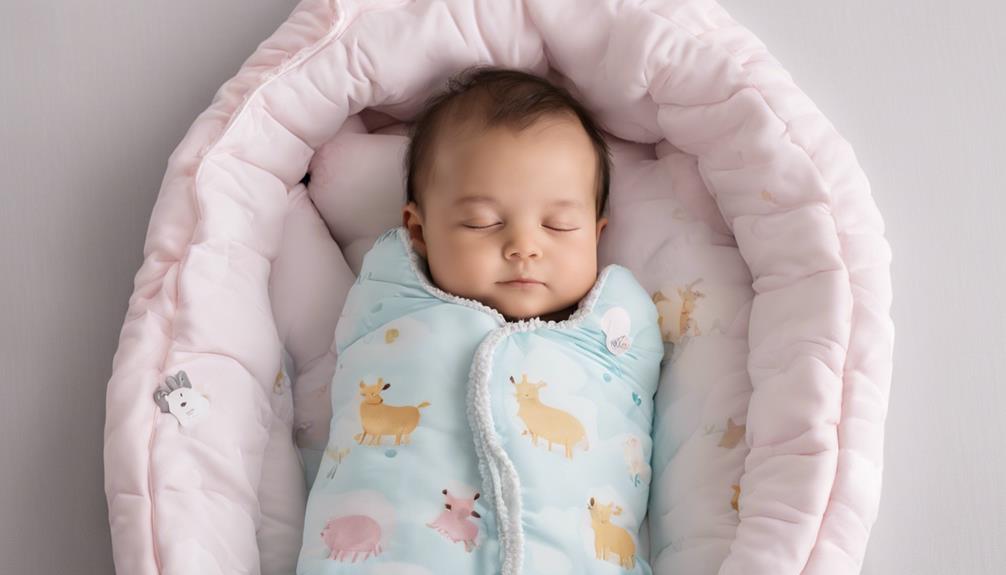
When considering newborn sleep options, the Baby Deedee Sleep Nest Lite Sleeping Bag Sack stands out for its convenient features and lightweight design. This sleep sack offers easy diaper changes with its quiet snaps, guaranteeing minimal disturbance during nighttime routines. The lightweight fabric of the Baby Deedee Sleep Nest Lite makes it ideal for warmer seasons or climates, providing a cozy yet breathable sleep environment for your newborn. Available in multiple sizes, this sack assures a secure and comfortable fit tailored to your baby's needs. Crafted from soft fabric, it eliminates the risks associated with loose blankets, promoting a safe sleep setting. The peace of mind that comes with using this sleep sack, knowing your little one is snug and secure, is truly invaluable. Below is a table summarizing the key features of the Baby Deedee Sleep Nest Lite Sleeping Bag Sack:
| Key Features | Description |
|---|---|
| Easy Diaper Changes | Quiet snaps for convenience during the night |
| Lightweight Fabric | Ideal for warmer months or climates |
| Multiple Sizes | Assures a snug and comfortable fit |
| Safe Sleep Environment | Cozy and secure design for peaceful nights |
Ergopouch Swaddle Sack 0.2 TOG
The Ergopouch Swaddle Sack boasts a 0.2 TOG rating, perfect for warmer climates and seasons.
Crafted from organic cotton, this sack guarantees breathability and comfort for your little one.
Its adaptable design grows with your baby, providing a secure and cozy fit throughout different sleep stages.
Ergopouch Swaddle Features
As parents looking for a sleep solution for our newborn, we found the Ergopouch Swaddle Sack 0.2 TOG to be a versatile and comfortable choice for warm nights or room temperatures. This swaddle sack is crafted from breathable organic cotton, ensuring ventilation and comfort for newborns.
Here are some key features of the Ergopouch Swaddle Sack:
- TOG rating of 0.2, perfect for warm months or room temperatures.
- Snug fit that mimics the feeling of being swaddled, promoting better sleep.
- Versatile design suitable for both day and night time sleeps, thanks to its lightweight construction and quality materials.
With these features, the Ergopouch Swaddle Sack offers a peaceful sleep solution for your little one.
Comfort and Design
Crafted from breathable organic cotton, the Ergopouch Swaddle Sack 0.2 TOG guarantees ultimate comfort and airflow for newborns during warmer months or in climates prone to overheating.
This cozy sleep sack with a low TOG rating of 0.2 makes sure that babies stay snug without getting too warm. The design provides a secure and comfortable environment for newborns to rest peacefully.
Parents love the convenience of the quiet snaps, allowing for easy diaper changes without disturbing their little one's sleep. The Ergopouch Swaddle Sack isn't only practical but also versatile, evolving with your baby as they grow.
It's a perfect choice for creating a soothing and safe sleeping space for your newborn.
Sizing and Fit
Moving on to discussing the sizing and fit of the Ergopouch Swaddle Sack 0.2 TOG, this sleep sack is designed in multiple sizes to guarantee a perfect and snug fit for newborns.
- The Ergopouch Swaddle Sack guarantees a secure and comforting swaddle experience for your little one.
- Made from breathable organic cotton, it keeps newborns comfortable without overheating.
- The convenient snaps on this swaddle sack make nighttime diaper changes quick and hassle-free.
This sack's thoughtful design not only prioritizes the snugness and security necessary for newborns but also ensures that parents can easily care for their baby's needs throughout the night.
Copper Pearl Sleep Bag

The Copper Pearl Sleep Bag offers a luxuriously soft and cozy sleep environment for newborns, ensuring a peaceful night's rest. This sleep sack comes in a variety of colors and designs, allowing parents to choose the perfect style for their little one.
With a suitable TOG rating, it provides just the right amount of warmth without causing overheating, giving parents peace of mind. The design of the Copper Pearl Sleep Bag makes diaper changes during the night a breeze, simplifying nighttime routines for tired parents.
Renowned for its softness, quality, and adorable designs, this sleep sack is a popular choice among parents seeking peaceful nights for their newborns. The Copper Pearl Sleep Bag truly combines comfort, functionality, and style to create a cozy and safe sleeping environment that both babies and parents will appreciate.
Baby Deedee Sleep Nest Sleeping Bag

The Baby Deedee Sleep Nest Sleeping Bag features convenient quiet snaps that allow for easy nighttime diaper changes, ensuring a peaceful and hassle-free sleep environment for newborns. This sleep sack is designed with the following features:
- Lightweight: The Baby Deedee Sleep Nest Sleeping Bag is lightweight, providing comfort for newborns without causing overheating issues.
- Snug Fit: Available in multiple sizes, this sleep sack offers a snug fit tailored to different babies, ensuring they feel secure and cozy during sleep.
- Easy On and Off: The design of the Baby Deedee Sleep Nest Sleeping Bag allows for quick and effortless changes, making those late-night diaper changes a breeze for tired parents.
The softness and quality of this sleep sack are highly appreciated by parents, who seek the best for their newborns. With the Baby Deedee Sleep Nest Sleeping Bag, quick nighttime changes are made simpler, allowing both babies and parents to rest peacefully.
HALO Sleepsack Blanket
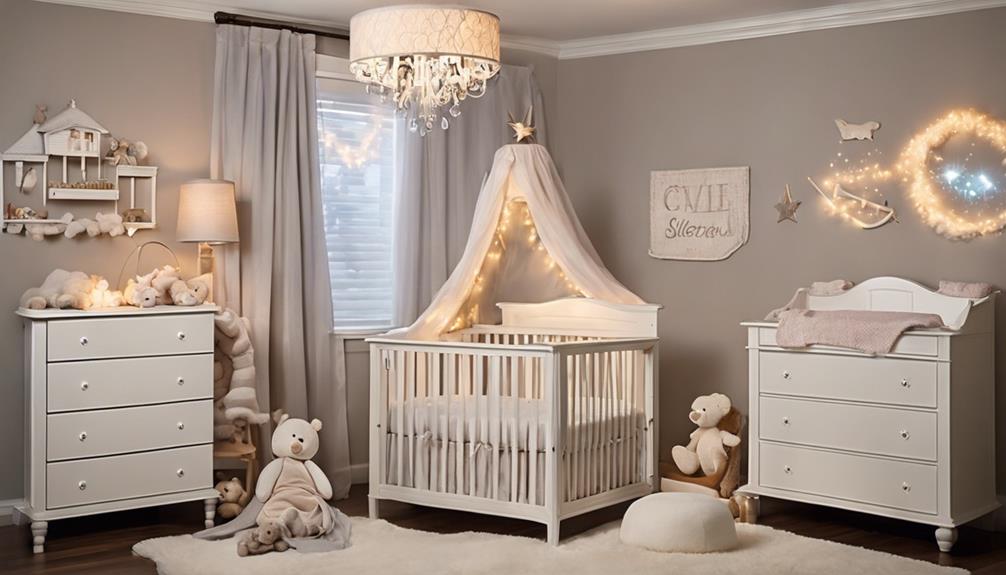
Nights with the HALO SleepSack Blanket offer newborns a safe and comfortable sleep environment designed to promote peaceful rest. This sleeveless wearable blanket features an inverted zipper, allowing for easy diaper changes without disturbing your baby's slumber. Crafted from soft and breathable fabric, the HALO SleepSack Blanket helps regulate your newborn's body temperature throughout the night, guaranteeing a cozy and secure sleeping experience. Recognized for its safety, this sleep sack is a recommended alternative to loose blankets in the crib, reducing the risk of suffocation or SIDS. Available in various sizes, the HALO SleepSack Blanket can accommodate newborns as they grow, providing a consistent and snug fit for the best comfort. Embrace the soothing embrace of the HALO SleepSack Blanket for your little one's peaceful nights.
| Features | Description |
|---|---|
| Sleeveless Design | Offers freedom of movement and prevents overheating. |
| Inverted Zipper | Facilitates easy diaper changes without disrupting sleep. |
| Soft Fabric | Gentle on newborn's skin and ensures a cozy sleeping experience. |
| Safe Sleep | Recognized as a safe alternative to loose blankets, reducing SIDS risk. |
| Various Sizes | Available in different sizes to accommodate newborns as they grow. |
Frequently Asked Questions
Is It OK to Put a Newborn in a Sleep Sack?
Yes, it's safe and beneficial to use a sleep sack for a newborn. It helps regulate temperature, reduces SIDS risk, and promotes better sleep quality. Always guarantee a snug fit to prevent loose fabric near the face and follow safe sleep guidelines.
What Sleep Sacks Are Best for Newborns?
We believe newborns benefit from sleep sacks that offer swaddling support, like the HALO SleepSack Swaddle, SwaddleMe Original Swaddle, and Love To Dream Swaddle Up. These options provide comfort and security for peaceful nights.
Do Sleep Sacks Help Babies Sleep Through the Night?
Absolutely, sleep sacks can work wonders for helping babies sleep through the night. They provide cozy comfort, regulate temperature, and reduce risks like SIDS. Our little one slept like a champ with these sacks!
Do Sleep Sacks Reduce Sids?
Yes, sleep sacks reduce the risk of SIDS by promoting safe sleep habits. They help maintain a clear airway, prevent overheating, and eliminate loose bedding hazards. Following guidelines and using sleep sacks are crucial for newborn safety.
Conclusion
To sum up, these 7 best newborn sleep sacks are absolute game-changers for promoting peaceful nights with your little one.
From the cozy HALO Sleepsack to the versatile Ergopouch Cocoon Swaddle Bag, these top picks offer the perfect combination of comfort, breathability, and ease of use.
Say goodbye to sleepless nights and hello to restful slumbers with these amazing sleep sacks. Your baby (and you) will thank you for choosing the best!
Pamela is the voice behind our vibrant community, fostering connections and conversations among parents. Her expertise in community engagement and personal experiences as a parent fuel her passion for creating a supportive space for all. Pamela believes that community is crucial for navigating the complexities of parenting, offering a place for sharing, learning, and growing together.
-

 Newborn Care2 months ago
Newborn Care2 months agoBest Position to Help Newborn Poop: A Step-by-Step Guide
-

 Breastfeeding/Formula Feeding3 months ago
Breastfeeding/Formula Feeding3 months agoWeight Loss Diet While Breastfeeding: Top Tips for Success
-

 Breastfeeding/Formula Feeding3 months ago
Breastfeeding/Formula Feeding3 months agoBalanced Diet While Breastfeeding: A How-To Guide
-

 Breastfeeding/Formula Feeding3 months ago
Breastfeeding/Formula Feeding3 months ago10 Keto Diet Tips While Breastfeeding
-

 Newborn Care3 months ago
Newborn Care3 months agoWhy Does My Newborn Keep Getting Hiccups: A Parent's Guide
-

 Sleep Training2 months ago
Sleep Training2 months agoEnsuring Your Newborn Sleeps Safely With Head to Side
-

 Newborn Care3 months ago
Newborn Care3 months agoHow to Get Your Newborn to Poop: A Step-by-Step Guide
-

 Newborn Care2 months ago
Newborn Care2 months agoUnderstanding Newborn Dark Green Poop: A Comprehensive Guide























